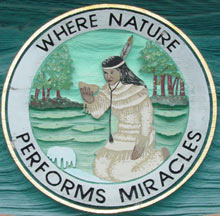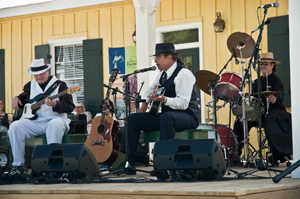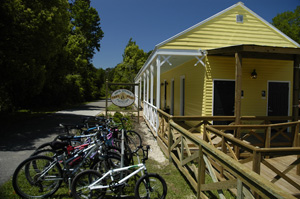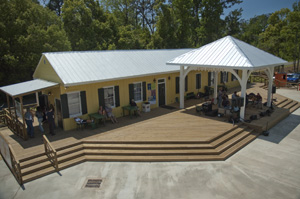TOWN OF ABITA SPRINGS |
The small south Louisiana town of Abita Springs is a twentieth century anachronism. Located in the heart of the piney woods north of Lake Ponchatrain near New Orleans, the town boasts one traffic light, four churches, two schools, and a few restraints. It is the kind of town that hardly exists anymore. It is a place where one can go into the local grocery store and know everyone there. It is a town with streets tucked beneath a thick canopy of live oaks flanked by beautiful turn-of-the century raised cottages. At the heart of this idyllic community is the town hall. |
|
The hall serves as a true community center in which bingo is played every Friday night, the Town Council holds monthly meetings, the local scouts meet, the schools and churches host fundraising activities, and, monthly, folks gather to dance across the old wooden floor to the strains of Cajun music. The hall serves one other very important function. On Saturday nights six times a year, in the months of March, April, May, September, October and November; the Town Hall becomes a concert auditorium. A diverse overflow crowd comprised of families, young people, seniors, and others from all walks of life crowd themselves into the hall to be treated to some of the best old-time country, bluegrass, traditional southern gospel and other forms of traditional Louisiana music played live, in its original form, acoustically, without the aid of electric amplifiers plugged into the guitars, mandolins, fiddles, dobros and other instruments used to provide the beautiful sounds that emanate from the raised platform that serves as the stage. |
 |
The Story of Abita SpringsThe area now known as Abita Springs was the home of Native Americans as far back as 2200 years ago. There was plentiful game, fish, and spring water that made this area very suitable for a comfortable life. A succession of different tribes continued to live here until the repressive government policies forced the Native Americans into Oklahoma. A few remained or returned later. |
|
In 1820 the first Louisiana pioneers settled here. According to one account, Etienne Le Fleud moved his family to Abita Creek opposite a Choctaw village of approximately 25 families. It was at the home of their son, Paul, that the Indian women would stop in later years on their journey from the Pearl River to Mandeville. The Indian women would catch the boat at Mandeville to cross the lake by schooner to New Orleans. Once there, they would peddle their well-made basket and herbs around the city, but especially at the French Market. |
 |
In 1887, a Covington physician conducted extensive tests on the water of Abita Springs. The tests revealed that the springs were mineral water with good medicinal qualities. He recommended that the Abita area was "very valuable for being a resort for boarders and invalids." Other physicians recommended Abita Springs for its climate and pure air. The town register contains names from many nationalities. A few of the early settlers were Afro-Americans. A large number of Germans moved to this area. Some English, Scot-Irish, and French names are evident. Many claim Choctaw heritage. |
|
The first major resort hotel to open was the Long Branch, built in 1880. This structure is still intact and one of the town's many buildings on the National Register of Historic Places. At the turn of the century, there were many hotels and boarding houses that were almost always filled with guests. New Orleans families would take a train to Abita Springs as they escaped from the heat and diseases of the city. And Aedesoegypti mosquito, which was the carrier of yellow fever, was not common in this area. In a way, it was yellow fever that helped Abita Springs to prosper and become a major resort area. |
 |
Automobiles and the control of the epidemic diseases created different lifestyles for the city folk. Abita Springs began to lose its appeal to tourists as a resort. Many of the Victorian summer homes and breezy wooden hotels stood empty, though some of the weekend guests began moving to Abita Springs to live and commuting to the city only to work. The town still appeals to those who seek a quieter life, fresh water, and the beauty of the Longleaf pine trees. A large number of artists, sculptors, jewelers, painters, writers, poets and philosophers have chosen the old houses of Abita Springs as their homes. The unique character of the town is its historic ambiance, its small town values, and an incredible amount of local talent. |
|
The town is governed by a mayor and city council. The Town Hall meetings are often well attended as local citizens participate in the decision making. Many active community organizations work together in Abita Springs. These organizations include the Ladies Progressive Club, the Abita Springs Civic Association, the Men's Club, the Senior Citizen's Club, the Veterans of Foreign Wars, the Volunteer Firemen, the Abita Recreation Committee, the Historic Committee, the Planning and Zoning Committee, Parent/Teacher organizations and several garden clubs. A few small restaurants and a coffee house attract the locals and their friends. The post office is a meeting spot for the "old regulars" who always know the day's happenings. Visitors like to come to Abita Springs. While there, they often drive into the park to see the pavilion. |
|
The pavilion sits in the center of the Abita Springs Park. It was designed for the 1884 Cotton Centennial Exposition and was later disassembled and brought to Abita Springs. It has been restored and is listed on the National Register of Historic Places. Once used by the summer tourists who drank from the springs beneath the pavilion, it is now used for numerous community activities. The yearly Abita Spring Water Festival in September brings the town's many organizations, clubs, the two schools and the residents of Abita together for a day-long celebration. |
 |
